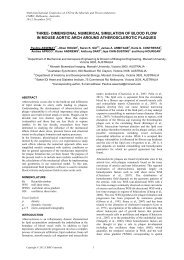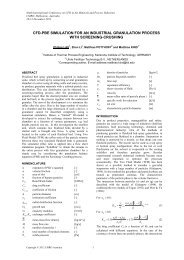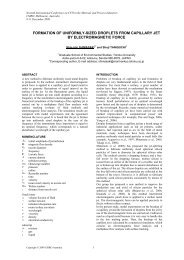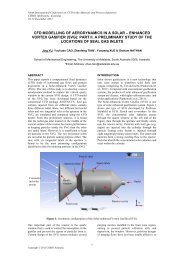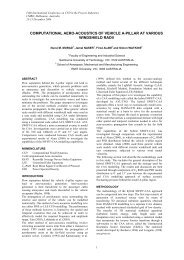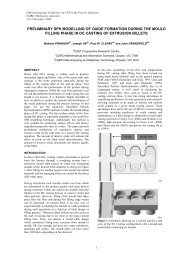simulation of offgas scrubbing by a combined eulerian ... - CFD
simulation of offgas scrubbing by a combined eulerian ... - CFD
simulation of offgas scrubbing by a combined eulerian ... - CFD
Create successful ePaper yourself
Turn your PDF publications into a flip-book with our unique Google optimized e-Paper software.
INTRODUCTION<br />
Due to the increasingly restricting legislation for the<br />
emission <strong>of</strong> pollutants there is a necessity for improved<br />
cleaning devices. Among the equipment utilised for<br />
cleaning <strong>of</strong> gases prior to release into the atmosphere, a<br />
Venturi wet scrubber, is one <strong>of</strong> the most effective. It can<br />
remove particles suspended in gaseous streams, achieving<br />
very high efficiencies even for particles <strong>of</strong> the order <strong>of</strong><br />
micrometers (Dullien ,1989).<br />
In Fig. 1 a Venturi scrubber is sketched. On principle, it<br />
comprises a convergence, a throat, and a diffuser. Dust<br />
laden gas enters the Venturi scrubber and accelerates in<br />
the convergence section. Due to the fact that the dust<br />
particles are very small they follow the gas stream nearly<br />
ideally. In the throat, the <strong>scrubbing</strong> liquid is injected and<br />
accelerated through drag force acting on the liquid<br />
droplets. As a result <strong>of</strong> the relative velocity between the<br />
droplets and the dust particles collisions occur and<br />
therefore the dust is captured <strong>by</strong> the droplets. The main<br />
collision mechanism in a Venturi scrubber is inertial<br />
impaction. Other collision mechanisms, such as<br />
interception and Brownian diffusion, are insignificant in<br />
comparison with inertial impaction (Boll, 1973). In a<br />
subsequent cyclone separator the droplets, whose<br />
diameters are much larger than the dust particles’, can be<br />
removed from the gas stream.<br />
Figure 1: Principle sketch <strong>of</strong> a Venturi scrubber.<br />
Venturi scrubbers can be classified as either a liquid<br />
injection type (Pease–Anthony type) or a wetted approach<br />
type according to how the liquid is supplied (Pulley,<br />
1997).<br />
In the Pease-Anthony scrubber the <strong>scrubbing</strong> liquid is<br />
injected through orifices which are located at the throat.<br />
The injected liquid jet breaks up due to aerodynamic<br />
forces acting between the droplets and the gas. In the<br />
wetted approach type scrubber the liquid is introduced as<br />
liquid film that flows along the wall. In that case droplets<br />
are entrained into the gas stream due to shear force acting<br />
between the gas and the liquid film.<br />
The main drawback <strong>of</strong> a Venturi scrubber is its large<br />
power consumption for operation which is determined <strong>by</strong><br />
the pressure drop. As Gonçalves (2001) pointed out, many<br />
computational models are available for the prediction <strong>of</strong><br />
pressure drop in Venturi scrubbers. One <strong>of</strong> the early<br />
models was presented <strong>by</strong> Calvert (1970). It assumes that<br />
all the liquid is atomized into droplets and subsequently<br />
accelerated up to the gas velocity at the end <strong>of</strong> the throat.<br />
Good results were achieved using the model <strong>of</strong><br />
Boll (1973) who derived a differential equation which is<br />
integrated over the Venturi length. The model accounts for<br />
acceleration <strong>of</strong> gas, droplets and wall friction. These<br />
effects were identified <strong>by</strong> Azzopardi (1984) to be the main<br />
Copyright © 2009 CSIRO Australia 2<br />
causes <strong>of</strong> pressure drop in Venturi scrubbers. Recently,<br />
more complex Computational Fluid Dynamics (<strong>CFD</strong>)<br />
models have been used <strong>by</strong> Pak (2006) to calculate the<br />
performance <strong>of</strong> Venturi scrubbers.<br />
The flow in a Venturi scrubber is very complex<br />
comprising the gas flow, liquid dispersed as droplets,<br />
liquid flowing as a film along the wall and dust particles<br />
dispersed in the gas stream. In this paper, the dispersed<br />
three-phase flow <strong>of</strong> the Venturi scrubber is numerically<br />
analysed using a three-dimensional Eulerian–Lagrangian<br />
approach. There<strong>by</strong>, representative droplets are traced in a<br />
Lagrangian frame <strong>of</strong> reference while the fine dust particles<br />
are treated as additional passive Eulerian phases which are<br />
allowed to drift with respect to the gas phase due to<br />
gravitational and centrifugal forces. For the computation<br />
<strong>of</strong> the dust phases’ diffusivity, a model considering the<br />
dust particle diameter and the local turbulence<br />
characteristics is used. Droplet break-up is considered <strong>by</strong><br />
the Taylor Analogy Breakup (TAB) model. For the dust<br />
capturing three mechanisms, namely impaction,<br />
interception and diffusion are considered. In a further step<br />
the influence <strong>of</strong> a wall film coupled with the gas and<br />
droplet phase is addressed <strong>by</strong> a model extension solving<br />
the shallow water equations at wall boundaries. Besides<br />
droplet deposition to the film, this sub-model also handles<br />
droplet entrainment from the film due to film detachment<br />
and wave cresting.<br />
In the next section the mathematical modelling <strong>of</strong> the<br />
complex phenomena is presented in a consecutive way<br />
before in subsequent section the results <strong>of</strong> this model are<br />
compared to experimental data <strong>of</strong> Haller (1989).<br />
The aim <strong>of</strong> this comprehensive representation <strong>of</strong> the<br />
<strong>scrubbing</strong> process is to get a model that is suitable for<br />
arbitrary wet <strong>scrubbing</strong> devices.<br />
MODEL DESCRIPTION<br />
Gas Flow<br />
For the gas flow a Eulerian approach is used solving the<br />
Reynolds averaged Navier-Stokes equations (RANS)<br />
using the standard k-ε turbulence model.<br />
It is assumed that there is no heat transfer between gaswalls,<br />
gas-droplets and gas-dust. The latter two<br />
assumptions postulate that the gas and the droplets (or<br />
dust particles) are at the same temperature which<br />
presumes a strong thermal coupling between the gas and<br />
droplet (or dust particle). Thus, in the following modelling<br />
both droplets and dust particles are assumed inert and<br />
isotherm.<br />
The conservation <strong>of</strong> mass <strong>of</strong> the gas phase can be written<br />
as:<br />
∂ρG<br />
+ ∇⋅<br />
( ρ Gu<br />
G ) = 0 .<br />
∂t<br />
(1)<br />
From the conservation <strong>of</strong> momentum one can derive:<br />
( ρ u )<br />
∂ G<br />
∂t<br />
with<br />
G<br />
+ ∇⋅<br />
( ρ u u ) = −∇p<br />
+ ∇⋅<br />
τ + ρ g + S<br />
G<br />
G<br />
G<br />
T<br />
( η<br />
+ η )( ∇u<br />
+ u )<br />
τ ∇<br />
= G G,<br />
t<br />
G<br />
G<br />
G<br />
(2)



